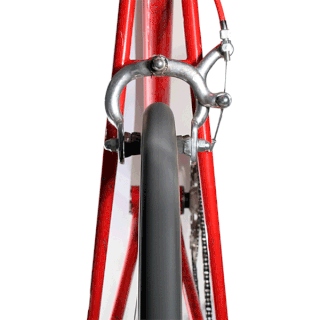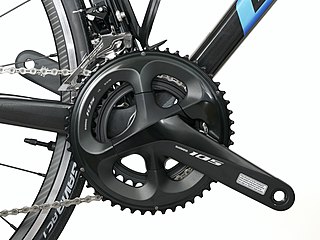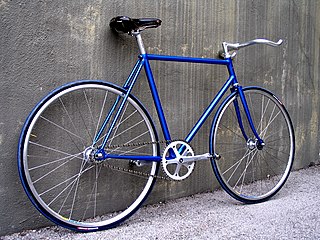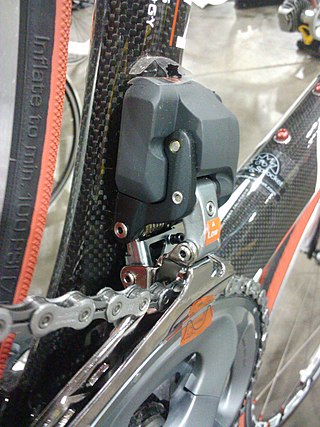
A tandem bicycle or twin is a form of bicycle designed to be ridden by more than one person. The term tandem refers to the seating arrangement, not the number of riders. Patents related to tandem bicycles date from the mid 1880s. Tandems can reach higher speeds than the same riders on single bicycles, and tandem bicycle racing exists. As with bicycles for single riders, there are many variations that have been developed over the years.

A bicycle brake reduces the speed of a bicycle or prevents the wheels from moving. The two main types are: rim brakes and disc brakes. Drum brakes are less common on bicycles.

A derailleur is a variable-ratio bicycle gearing system consisting of a chain, multiple sprockets of different sizes, and a mechanism to move the chain from one sprocket to another.

A hub gear, internal-gear hub, internally geared hub or just gear hub is a gear ratio changing system commonly used on bicycles that is implemented with planetary or epicyclic gears. The gears and lubricants are sealed within the shell of the hub gear, in contrast with derailleur gears where the gears and mechanism are exposed to the elements. Changing the gear ratio was traditionally accomplished by a shift lever connected to the hub with a Bowden cable, and twist-grip style shifters have become common.
Shimano, Inc., originally Shimano Iron Works (島野鐵工所) and later Shimano Industries, Inc. (島野工業株式会社), is a Japanese multinational manufacturing company for cycling components, fishing tackle and rowing equipment, who also produced golf supplies until 2005 and snowboarding gear until 2008. Named after founder Shozaburo Shimano and headquartered in Sakai, Osaka Prefecture, the company has 32 consolidated and 11 unconsolidated subsidiaries, with the primary manufacturing plants based in Kunshan (China), Malaysia and Singapore.

The crankset or chainset is the component of a bicycle drivetrain that converts the reciprocating motion of the rider's legs into rotational motion used to drive the chain or belt, which in turn drives the rear wheel. It consists of one or more sprockets, also called chainrings or chainwheels attached to the cranks, arms, or crankarms to which the pedals attach. It is connected to the rider by the pedals, to the bicycle frame by the bottom bracket, and to the rear sprocket, cassette or freewheel via the chain.

A bicycle chain is a roller chain that transfers power from the pedals to the drive-wheel of a bicycle, thus propelling it. Most bicycle chains are made from plain carbon or alloy steel, but some are nickel-plated to prevent rust, or simply for aesthetics.

The bottom bracket on a bicycle connects the crankset (chainset) to the bicycle and allows the crankset to rotate freely. It contains a spindle to which the crankset attaches, and the bearings that allow the spindle and crankset to rotate. The chainrings and pedals attach to the cranks. Bottom bracket bearings fit inside the bottom bracket shell, which connects the seat tube, down tube and chain stays as part of the bicycle frame.

A single-speed bicycle is a type of bicycle with a single gear ratio. These bicycles are without derailleur gears, hub gearing or other methods for varying the gear ratio of the bicycle.

A fixed-gear bicycle is a bicycle that has a drivetrain with no freewheel mechanism such that the pedals always will spin together with the rear wheel. The freewheel was developed early in the history of bicycle design but the fixed-gear bicycle remained the standard track racing design. More recently the "fixie" has become a popular alternative among mainly urban cyclists, offering the advantage of simplicity compared with the standard multi-geared bicycle.
SRAM LLC is a privately owned bicycle component manufacturer based in Chicago, Illinois, United States, founded in 1987. SRAM is an acronym comprising the names of its founders, Scott, Ray, sAM,. The company produces a range of internally developed cycling components, including Grip Shift, separate gravel, road, and mountain drivetrains from 7 to 12 speed. SRAM developed the Eagle line of mountain bike specific drivetrain components intended to improve shifting performance. SRAM was also the first to release a dedicated "one by" drivetrain with a single front chain-ring.

A cyclocomputer, cycle computer, cycling computer or cyclometer is a device mounted on a bicycle that calculates and displays trip information, similar to the instruments in the dashboard of a car. The computer with display, or head unit, usually is attached to the handlebar for easy viewing. Some GPS watches can also be used as display.

On a bicycle, the cassette or cluster is the set of multiple sprockets that attaches to the hub on the rear wheel. A cogset works with a rear derailleur to provide multiple gear ratios to the rider. Cassettes come in two varieties, freewheels or cassettes, of which cassettes are a newer development. Although cassettes and freewheels perform the same function and look almost the same when installed, they have important mechanical differences and are not interchangeable.

Bicycle gearing is the aspect of a bicycle drivetrain that determines the relation between the cadence, the rate at which the rider pedals, and the rate at which the drive wheel turns.

Flip-flop hubs, also called double-sided hubs, are rear bicycle hubs that are threaded to accept fixed cogs and/or freewheels on both sides.

An electronic gear-shifting system is a method of changing gears on a bicycle, which enables riders to shift with electronic switches instead of using conventional control levers and mechanical cables. The switches are connected by wire or wirelessly to a battery pack and to a small electric motor that drives the derailleur, switching the chain from cog to cog. An electronic system can switch gears faster and, because the system does not use Bowden cables and can calibrate itself, it may require less maintenance.

Bicycle drivetrain systems are used to transmit power on bicycles, tricycles, quadracycles, unicycles, or other human-powered vehicles from the riders to the drive wheels. Most also include some type of a mechanism to convert speed and torque via gear ratios.

Mountain bike trials, also known as observed trials, is a discipline of mountain biking in which the rider attempts to pass through an obstacle course without setting foot to ground. Derived from motorcycle trials, it originated in Catalonia, Spain as trialsín and is said to have been invented by Pere Pi, the father of Ot Pi, a world champion motorcycle trials rider. Pi's father had wanted his son to learn motorcycle trials by practicing on an ordinary bicycle.

















